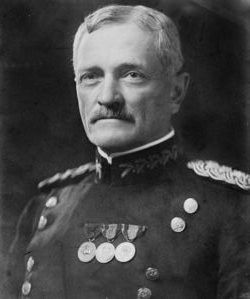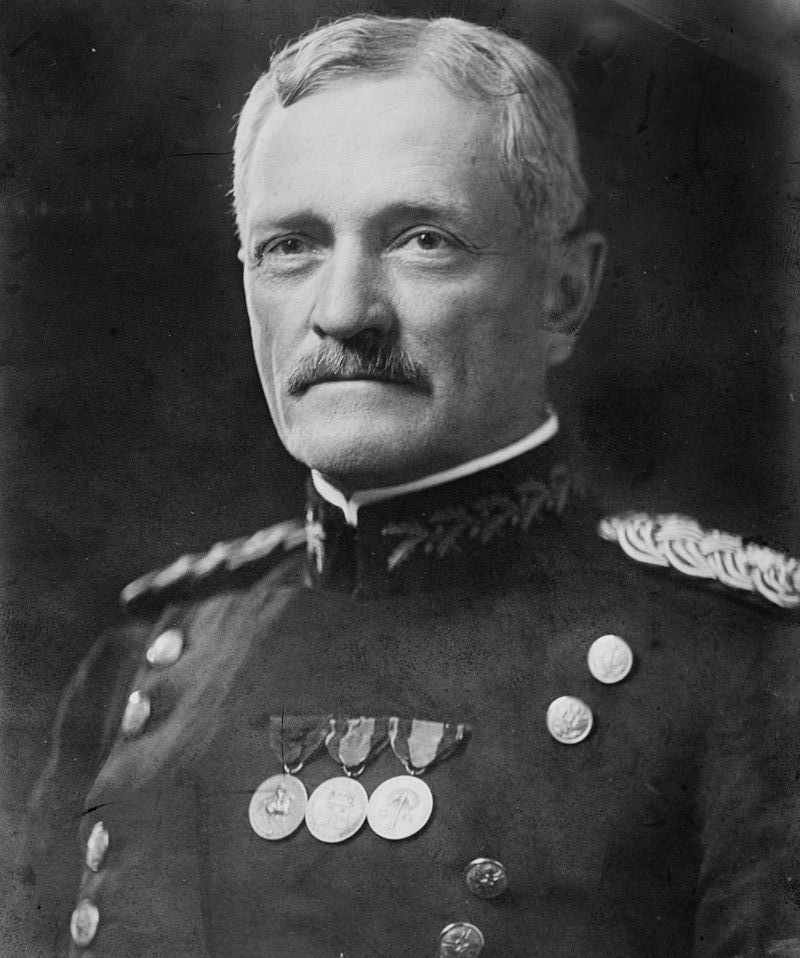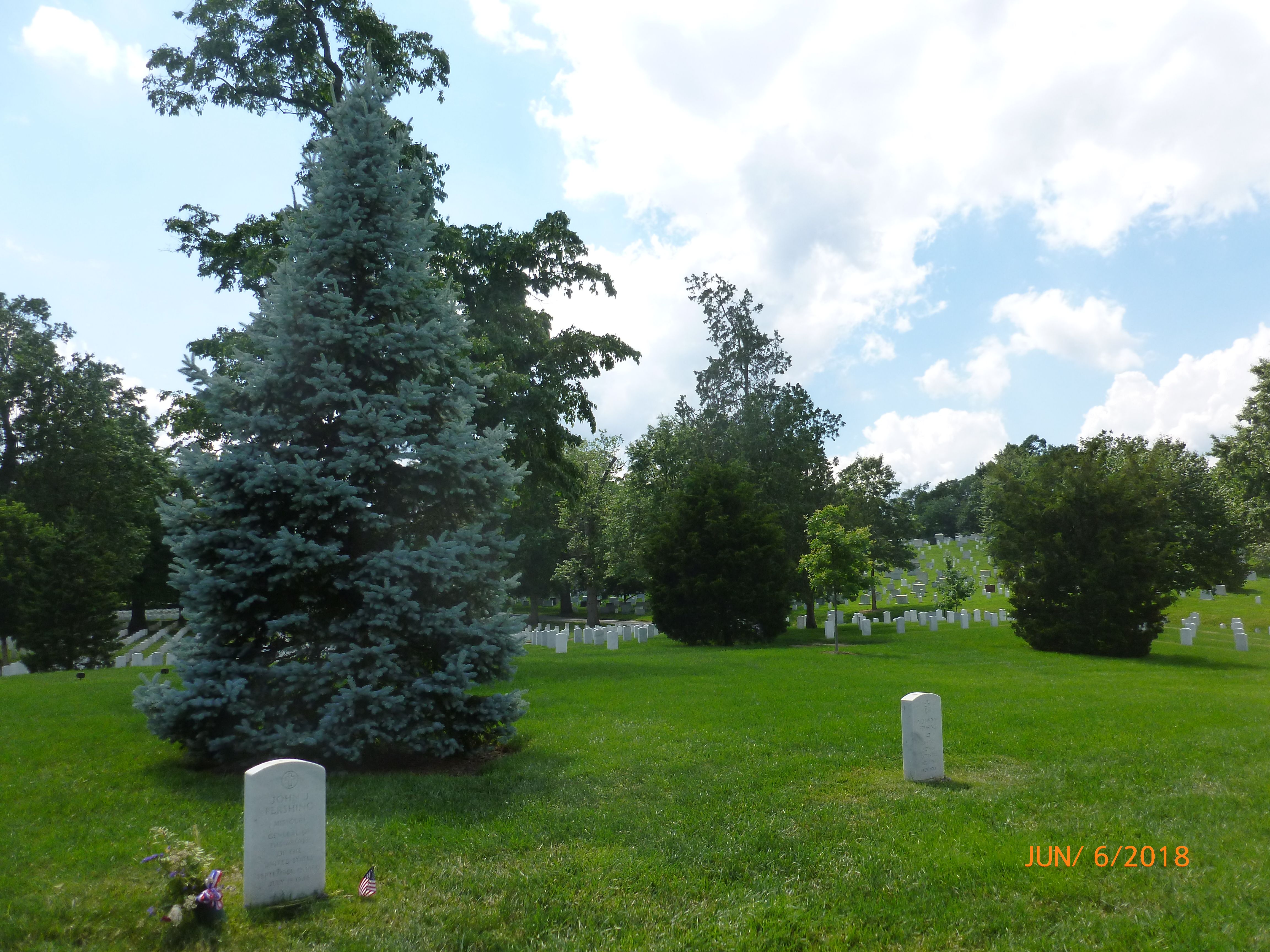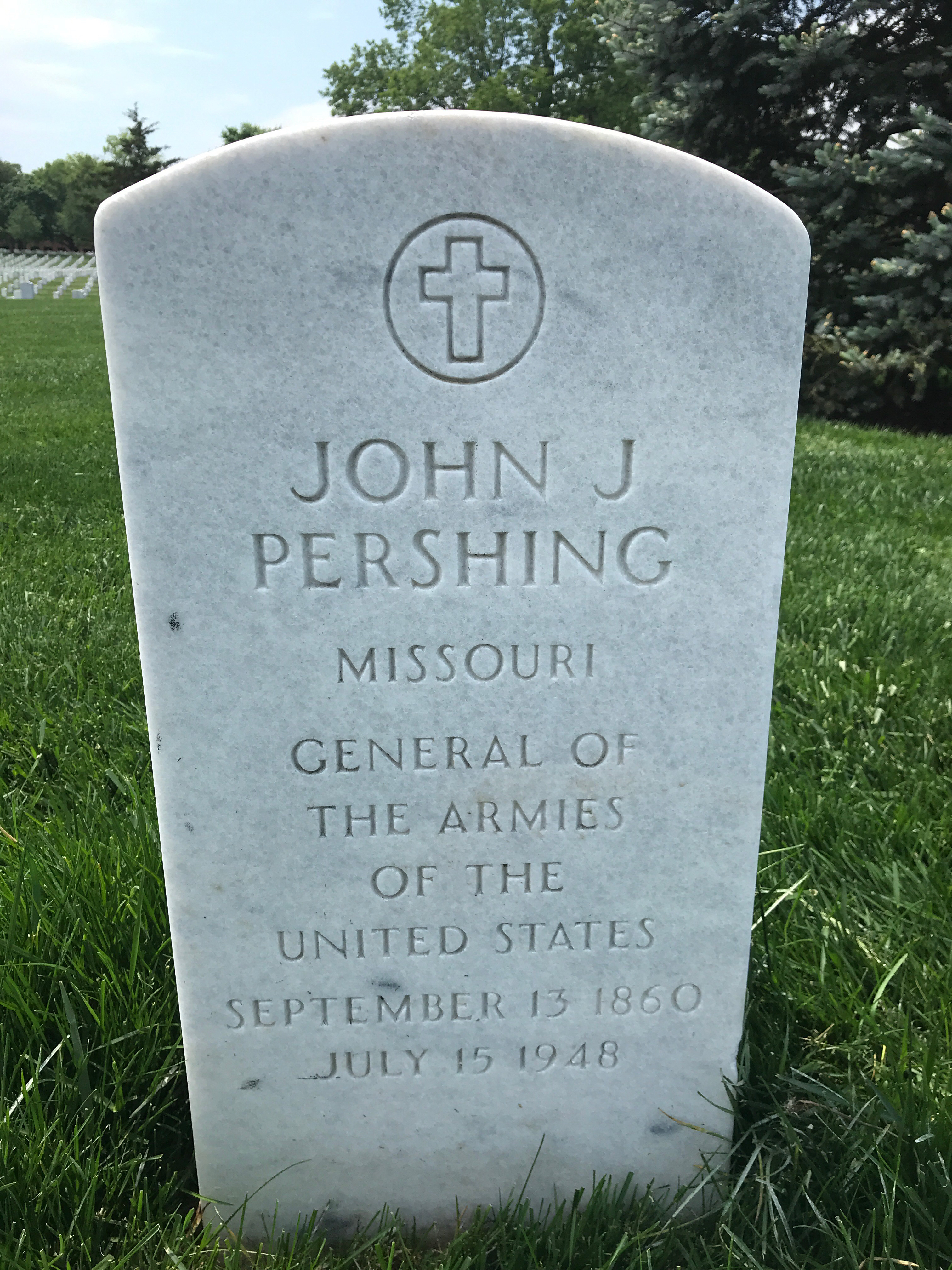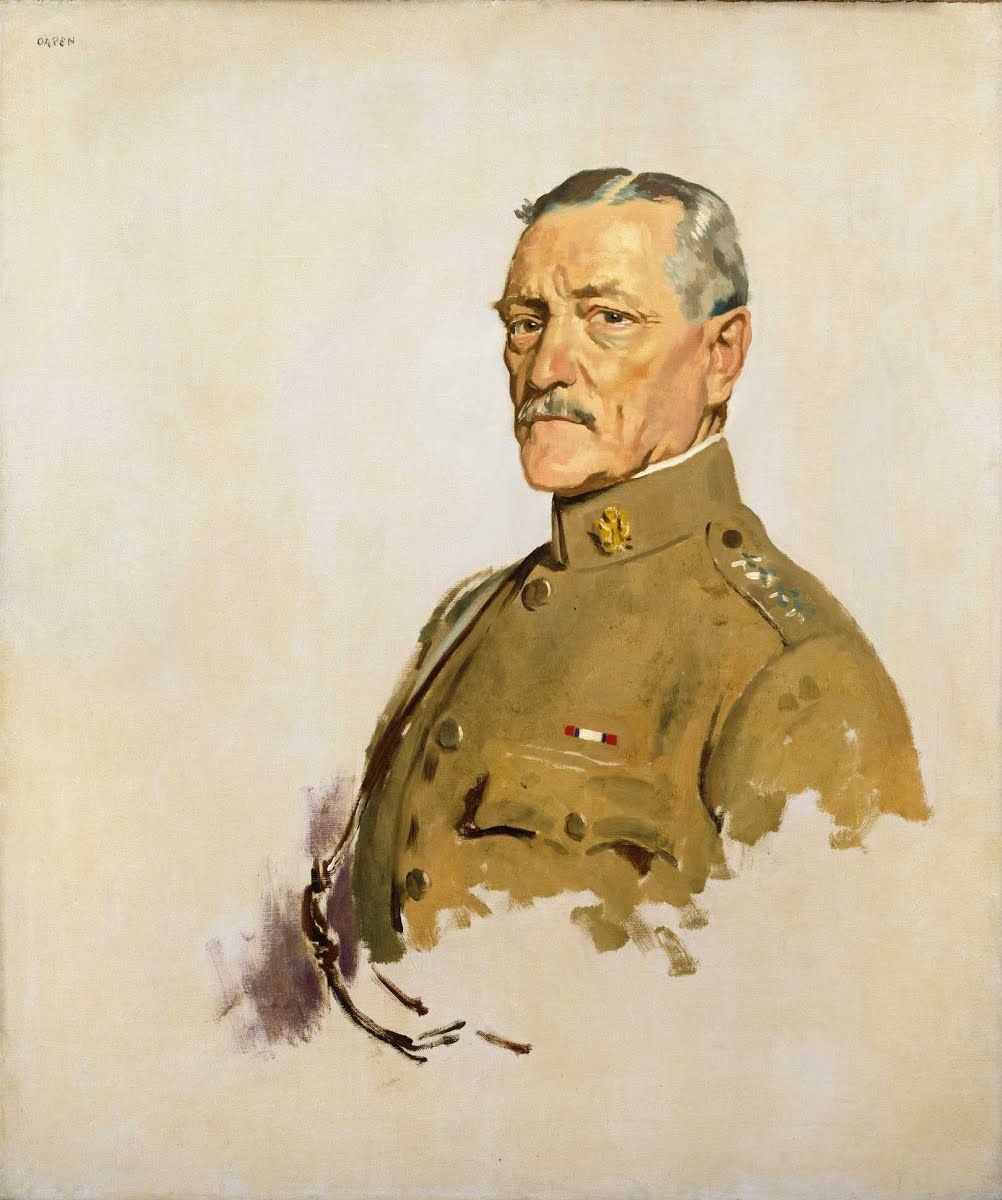United States Army General. He is remembered worldwide for serving from 1917 to 1918 as the commander of the American Expeditionary Forces on the Western Front during World War I. Born in Laclede, Missouri, he was the son of a railroad switchman. At the age of 17, he taught in a rural school for African-American children to earn enough money to pay for his college education at Kirksville Normal School, which is now Truman State University in Kirksville, Missouri. In 1881, answering an advertisement for the United States Military Academy's entrance exam, he sat for the exam, earning an entry to West Point in 1882. Graduating 30th out of 70 students, he also was President of his class and Captain of Cadets. He received his commission in the Cavalry and was ordered to the Western frontier, fighting in the Apache campaign in New Mexico and Arizona under the command of General Nelson A. Miles and earning his first combat citation. He also fought against the Sioux but did not participate in the famous Massacre at Wounded Knee. From 1891 until 1895, he served as a Professor of Military Science at the University of Nebraska, while receiving a law degree. Later he returned to the United States Military Academy as a tactical officer. As part of the Spanish-American War, he was sent to the Philippines in 1898 where he earned a Silver Star. He organized the Insular Bureau, under which the affairs of the Philippine Islands and Puerto Rico are still administered. In 1899, as a Captain, he returned to the Philippines where he put down an uprising of the Moros and received the personal congratulations of Secretary of War Elihu Root. In 1904, he was assigned as Military Attaché of the American Embassy in Tokyo, Japan, during the Russo-Japanese War. The following year, he returned to the United States and married Helen Frances Warren, the daughter of United States Senator Francis E. Warren. In 1906, President Theodore Roosevelt promoted him over 862 other officers, which prompted a great deal of professional resentment. The promotion raised rumors of favoritism and political dealing, fueled by the fact that his father-in-law was chairman of the Senate Military Affairs Committee. Regardless of the rumors, he continued to serve with great distinction and returned to the Philippines again as Military Commander and remained there until 1913. In January of 1914, he returned to the United States where President Woodrow Wilson assigned him under General Frederick Funston; Wilson then ordered him to "pursue and disperse" Pancho Villa and his band of Mexican guerrillas. Leaving his family at the Presidio in San Francisco, California, he went to El Paso, Texas, to coordinate his campaign. Prior to beginning this campaign, he received word his wife and three daughters had died in a house fire. Only his 6-year-old son had survived because of the heroics of the family's maid. Due to this tragic personal loss, he left his duties, but only long enough to see to the burial of his family, then returned and pressed on with his assignment. Though he failed to capture Villa, he effectively stopped Villa's terrorism and earned himself a promotion to Major General. It was also during this campaign that he earned the nickname "Black Jack" by commanding, and advocating, the 10th Calvary, a distinguished regiment of Black troops, often called the "Buffalo Soldiers." Once he returned to Washington, D.C. in 1917, and due to the sudden death of General Funston, President Wilson, on the advice of his Military Attaché, Major Douglas McArthur, named him to command the American Expeditionary Forces being sent to France after America's declaration of war on Germany. The Army he was to command did not exist yet; his task was to create it. One of his first actions upon arriving in France was to pay respects at the tomb of the Marquis de Lafayette. As he laid a wreath on the French soldier's grave, his aide announced, "Lafayette, we are here!" This signified to the French people that America was ready to assist them as they had the young American Republic in 1776. He fought diligently to maintain the integrity of the American forces. He did not, and would not, concur with the plan to use American forces only as replacements for depleted French and British troops. He also refused to allow any American forces to fight separately; insisting that all American forces fight together as a unit. It was his American troops who defeated the Germans in the St. Mihiel Salient in September of 1918. In October, the Americans fought bravely against the Germans along the Hindenburg Line during the Meuse-Argonne Offensive, and, on November 11, 1918, the Armistice was declared. Upon his return to the United States, he received a hero's welcome. Congress conferred upon him the "Thanks of Congress" and the special rank of "General of the Armies of the United States." With this rank, he was given the option of 5 stars, but declined the offer. He served as Army Chief of Staff from 1921 until his retirement in 1924. He went on to chair the American Battle Monuments Commission and write his two-volume memoirs, which earned him a Pulitzer Prize. Though he lived at Walter Reed Hospital in Washington, D.C., he was called upon during World War II for advice and counsel by the Army Chief of Staff General George C. Marshall. In 1948, upon his death, his funeral cortege was led by the President of the United States, Harry S. Truman, a veteran "doughboy" from World War I. After the funeral service in the Memorial Amphitheater, one of only nine to ever be held there, his last requests were honored. He had asked that he be buried with the men he had led and fought beside. He was interred in a special plot which placed him in front of his doughboys. His last request was that his grave be marked with the same white government regulation tombstone that marked the graves of his men. He was the recipient of the Distinguished Service Cross, the Distinguished Service Medal, the Silver Star, and many foreign awards. Buried beside him is his grandson, 2nd Lieutenant Richard Warren Pershing, who was killed in action in Vietnam. Pershing County, Nevada is named after him.
United States Army General. He is remembered worldwide for serving from 1917 to 1918 as the commander of the American Expeditionary Forces on the Western Front during World War I. Born in Laclede, Missouri, he was the son of a railroad switchman. At the age of 17, he taught in a rural school for African-American children to earn enough money to pay for his college education at Kirksville Normal School, which is now Truman State University in Kirksville, Missouri. In 1881, answering an advertisement for the United States Military Academy's entrance exam, he sat for the exam, earning an entry to West Point in 1882. Graduating 30th out of 70 students, he also was President of his class and Captain of Cadets. He received his commission in the Cavalry and was ordered to the Western frontier, fighting in the Apache campaign in New Mexico and Arizona under the command of General Nelson A. Miles and earning his first combat citation. He also fought against the Sioux but did not participate in the famous Massacre at Wounded Knee. From 1891 until 1895, he served as a Professor of Military Science at the University of Nebraska, while receiving a law degree. Later he returned to the United States Military Academy as a tactical officer. As part of the Spanish-American War, he was sent to the Philippines in 1898 where he earned a Silver Star. He organized the Insular Bureau, under which the affairs of the Philippine Islands and Puerto Rico are still administered. In 1899, as a Captain, he returned to the Philippines where he put down an uprising of the Moros and received the personal congratulations of Secretary of War Elihu Root. In 1904, he was assigned as Military Attaché of the American Embassy in Tokyo, Japan, during the Russo-Japanese War. The following year, he returned to the United States and married Helen Frances Warren, the daughter of United States Senator Francis E. Warren. In 1906, President Theodore Roosevelt promoted him over 862 other officers, which prompted a great deal of professional resentment. The promotion raised rumors of favoritism and political dealing, fueled by the fact that his father-in-law was chairman of the Senate Military Affairs Committee. Regardless of the rumors, he continued to serve with great distinction and returned to the Philippines again as Military Commander and remained there until 1913. In January of 1914, he returned to the United States where President Woodrow Wilson assigned him under General Frederick Funston; Wilson then ordered him to "pursue and disperse" Pancho Villa and his band of Mexican guerrillas. Leaving his family at the Presidio in San Francisco, California, he went to El Paso, Texas, to coordinate his campaign. Prior to beginning this campaign, he received word his wife and three daughters had died in a house fire. Only his 6-year-old son had survived because of the heroics of the family's maid. Due to this tragic personal loss, he left his duties, but only long enough to see to the burial of his family, then returned and pressed on with his assignment. Though he failed to capture Villa, he effectively stopped Villa's terrorism and earned himself a promotion to Major General. It was also during this campaign that he earned the nickname "Black Jack" by commanding, and advocating, the 10th Calvary, a distinguished regiment of Black troops, often called the "Buffalo Soldiers." Once he returned to Washington, D.C. in 1917, and due to the sudden death of General Funston, President Wilson, on the advice of his Military Attaché, Major Douglas McArthur, named him to command the American Expeditionary Forces being sent to France after America's declaration of war on Germany. The Army he was to command did not exist yet; his task was to create it. One of his first actions upon arriving in France was to pay respects at the tomb of the Marquis de Lafayette. As he laid a wreath on the French soldier's grave, his aide announced, "Lafayette, we are here!" This signified to the French people that America was ready to assist them as they had the young American Republic in 1776. He fought diligently to maintain the integrity of the American forces. He did not, and would not, concur with the plan to use American forces only as replacements for depleted French and British troops. He also refused to allow any American forces to fight separately; insisting that all American forces fight together as a unit. It was his American troops who defeated the Germans in the St. Mihiel Salient in September of 1918. In October, the Americans fought bravely against the Germans along the Hindenburg Line during the Meuse-Argonne Offensive, and, on November 11, 1918, the Armistice was declared. Upon his return to the United States, he received a hero's welcome. Congress conferred upon him the "Thanks of Congress" and the special rank of "General of the Armies of the United States." With this rank, he was given the option of 5 stars, but declined the offer. He served as Army Chief of Staff from 1921 until his retirement in 1924. He went on to chair the American Battle Monuments Commission and write his two-volume memoirs, which earned him a Pulitzer Prize. Though he lived at Walter Reed Hospital in Washington, D.C., he was called upon during World War II for advice and counsel by the Army Chief of Staff General George C. Marshall. In 1948, upon his death, his funeral cortege was led by the President of the United States, Harry S. Truman, a veteran "doughboy" from World War I. After the funeral service in the Memorial Amphitheater, one of only nine to ever be held there, his last requests were honored. He had asked that he be buried with the men he had led and fought beside. He was interred in a special plot which placed him in front of his doughboys. His last request was that his grave be marked with the same white government regulation tombstone that marked the graves of his men. He was the recipient of the Distinguished Service Cross, the Distinguished Service Medal, the Silver Star, and many foreign awards. Buried beside him is his grandson, 2nd Lieutenant Richard Warren Pershing, who was killed in action in Vietnam. Pershing County, Nevada is named after him.
Bio by: Ugaalltheway
Inscription
MISSOURI
GENERAL OF THE ARMIES OF THE UNITED STATES
YOU ARE REMEMBERED 118,516 BRAVE AMERICANS WHO DIED IN WORLD WAR I
"The devotion, their valor and their sacrifice will live forever in the heart of their grateful countrymen."
General of the Armies John J. Pershing
Family Members
Other Records
Advertisement
See more Pershing memorials in:
Advertisement
